A recent addition to my WWII JAPANESE AVIATION collection.
One of the most damaging Kamikaze attacks of WWII. It’s extraordinary that the identity of the kamikaze pilot is known! The U.S.S. Bunker Hill was targeted.
Originally shared by Pete Panozzo
KIYOSHI OGAWA
Kiyoshi Ogawa (Japanese: 小川 清 Ogawa Kiyoshi, October 23, 1922 – May 11, 1945) was a Japanese naval aviator ensign (少尉) of the Imperial Japanese Navy during World War II. As a kamikaze pilot, Ensign Ogawa’s final action took place on May 11, 1945, during the Battle of Okinawa. Piloting a bomb-laden Mitsubishi Zero fighter during Operation Kikusui No. 6, Ogawa at the age of 22 flew through American anti-aircraft fire and attacked the U.S. Navy aircraft carrier USS Bunker Hill. He dropped a 250-kilogram (550 lb) bomb, never pulled out of the dive, and crashed deliberately into the flight deck near the control tower of the American aircraft carrier. The bomb penetrated Bunker Hill’s flight deck and exploded, gasoline fires flamed up and several explosions took place when re-armed and re-fueled planes on deck exploded and caught fire. Nearly 400 American sailors died with Ogawa and the ship was disabled for the remainder of the war.[1]
Ogawa’s kamikaze attack
On the morning of May 11, 1945, USS Bunker Hill, the flagship of Vice Admiral Marc Mitscher, participated as part of TG 58.3 in carrier operations 122 kilometres east of Okinawa, supporting the Okinawa invasion. Bunker Hill and the Fifth Fleet sortied from Ulithi in February 1945, for strikes against Okinawa and the Home Islands. Bunker Hill had provided aircraft for the massive effort to sink the Japanese battleship Yamato on April 7.
On May 11, the Imperial Japanese Navy carried out a massive kamikaze mission called Kikusui Rokugi Sakusen (Operation Kikusui “Floating Chrysanthemums” No. 6). On the early morning, pilots of the Tokkōtai suicide squadrons took off from their bases; among those pilots, there was Kiyoshi Ogawa, a member of the Dai-nana Showa-tai Squadron, flying a Zero, modified to carry a 250 kg (550 pound) bomb underneath the fuselage. That day, Ensign Ogawa was ready to make a suicide attack on American ships near Okinawa.
Off the coast of Okinawa, Ogawa, along with Yasunori Seizo, another Zero pilot of his squadron, sighted Bunker Hill. On Mother’s Day, May 11, 1945, Bunker Hill had been at sea and in continuous action for 58 days. With a slight lull that day, the ship was at condition One Easy, with ventilators open and the crew, including Vice-Admiral Marc Mitscher, commander of Task Force 58, trying to relax. At 1004, Marine Captain James E. Swett, flying his F4U-1C Corsair on Combat air patrol, frantically radioed “Alert! Alert! Two planes diving on the Bunker Hill!” [5]
Ogawa and his wingman had just swept down on Bunker Hill so quickly that her gunners barely had time to respond. Ogawa’s wingman released a 550-lb bomb which smashed through the flight deck and out the side, exploding just above the water. The aircraft crashed into the flight deck and skidded over the side, destroying nearly all of the 34 fully armed and fueled planes parked on the flight deck. At the same time, Ogawa was completing his dive with his Zero through the AA fire, aiming for the flight deck near the bridge of the ship to cause the most damage, as kamikaze pilots were trained to do. At nearly a vertical dive, Ogawa dropped his 550-lb bomb just before impact with the flight deck, crashing near the island at about 10:05 hours.
The 250 kg (550 lb) bomb penetrated Bunker Hill’s flight deck and exploded. Gasoline fires flared up and several explosions occurred. The bomb smashed through the flight deck, but did not make it through the hangar deck where it exploded. Bunker Hill’s armor protecting the machinery spaces below had proven effective. A significant improvement of Essex-class ships like the Bunker Hill over the other US carriers at the time was that they were equipped with a more heavily armored deck, plus a second armored deck on the hangar level designed to detonate bombs before they reached the vital machinery and electronic spaces below.[6]
Ogawa’s bomb blew a large hole into the flightdeck close to the bridge. On the flagbridge, Vice-Admiral Mitscher barely escaped, but lost many of his staff officers including his own medical officer.
Many of Bunker Hill’s pilots died either in their planes or inside the skin of the ship during the attack. 30 fighter pilots of Bunker Hill’s air group, CVG-84, were killed in the ready room by the explosion of the bomb which immediately burned all oxygen in the room and asphyxiated the men.
His flagship in bad shape, Vice Admiral Mitscher decided to leave the ship while he still could. The destroyer USS English went alongside Bunker Hill, to help in the fighting of fires and to take off Vice Admiral Mitscher, transferring his flag to the newly repaired carrier Enterprise.
Of Bunker Hill’s crew, 373 were killed, 264 were wounded and 43 were missing. Hundreds of crewmen had been either blown overboard or were forced to jump to escape the fires. Captain James E. Swett collected about 24 of the circling airplanes, mostly F4U Corsairs, and they dropped dye markers and Mae Wests for the crewmen swimming in the oily water around the stricken carrier.[7] Bunker Hill finally was saved and the crippled carrier sailed the 11,000 kilometres (7,000 mi) to Puget Sound Navy Yard under her own steam. Upon arrival, she was called the “most extensively damaged ship” ever to enter the yard, her repairs took the rest of the war.
According to Robert Schock, a U.S. Navy diver on board Bunker Hill, Ogawa’s aircraft was not completely destroyed after penetrating the flight deck, but remained partially intact and did not catch fire. Instead, the wreckage rested on the hangar deck of Bunker Hill, half awash in water, with live wires sparking all around. Schock found Ogawa dead in the cockpit, and removed Ogawa’s name tag from his flight suit, along with a letter Ogawa carried with him on his last mission, some photographs, a belt from Ogawa’s parachute harness, and a large smashed aviator watch of the type that Japanese pilots wore around their necks.
On March 27, 2001, Yoko Ogawa, Ogawa’s grandniece, her mother, and Masao Kunimine, an old college friend of Kiyoshi Ogawa, received these personal effects in San Francisco, nearly 56 years after Operation Kikusui No. 6.[8]
In his last letter, Ensign Kiyoshi Ogawa wrote to his parents:
“I will make a sortie, flying over those calm clouds in a peaceful emotion. I can think about neither life nor death. A man should die once, and no day is more honorable than today to dedicate myself for the eternal cause. (…) I will go to the front smiling. On the day of the sortie too, and forever.[9]”
https://en.m.wikipedia.org/wiki/Kiyoshi_Ogawa
Photo 1: Kamikaze pilot Ensign Kiyoshi Ogawa, who damaged the carrier USS Bunker Hill during Operation Kikusui No. 6 on May 11th, 1945.
Photos 2-6: U. S. S. Bunker Hill damage received from Ogawa’s attack
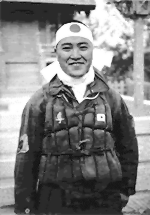

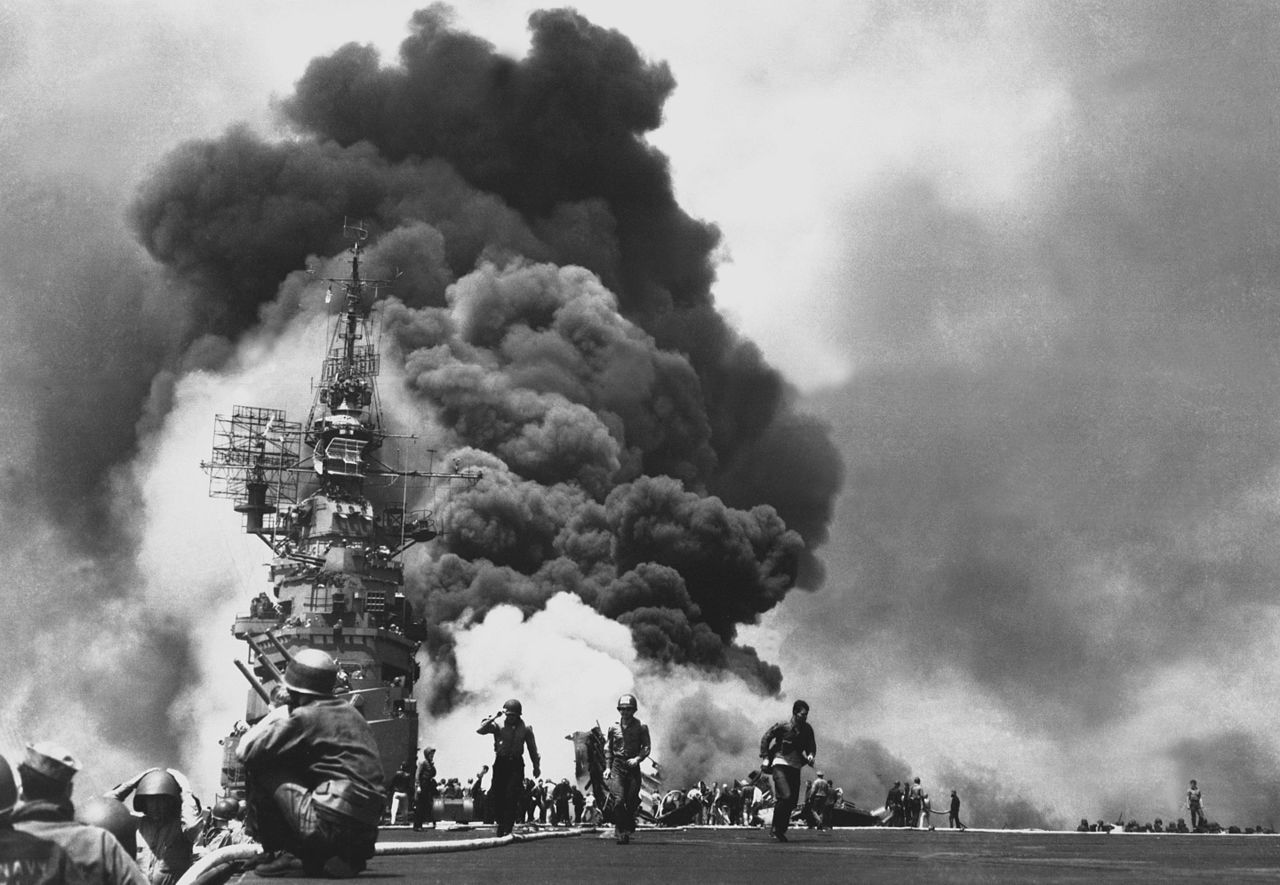
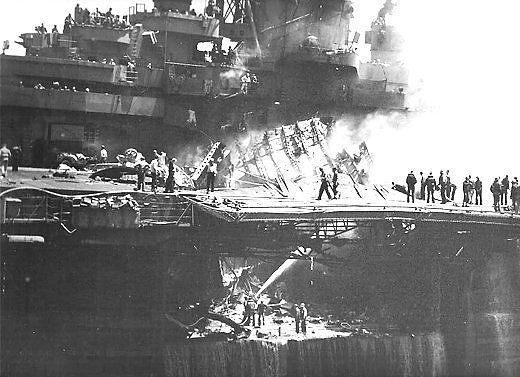
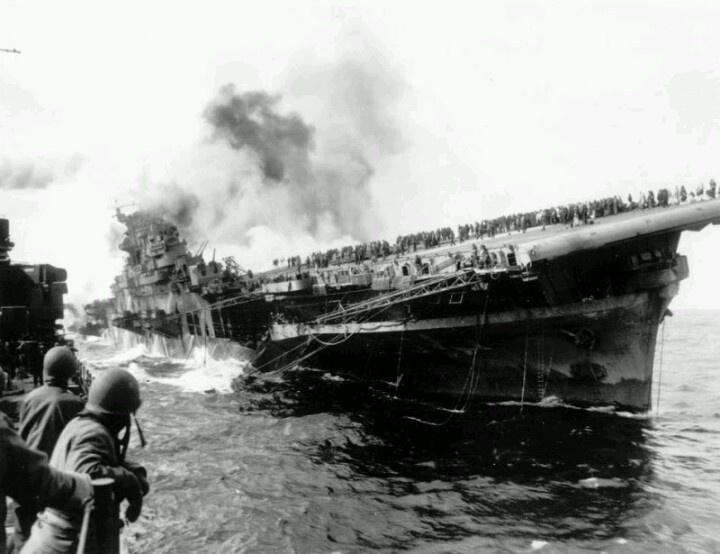
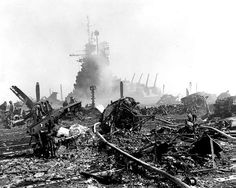
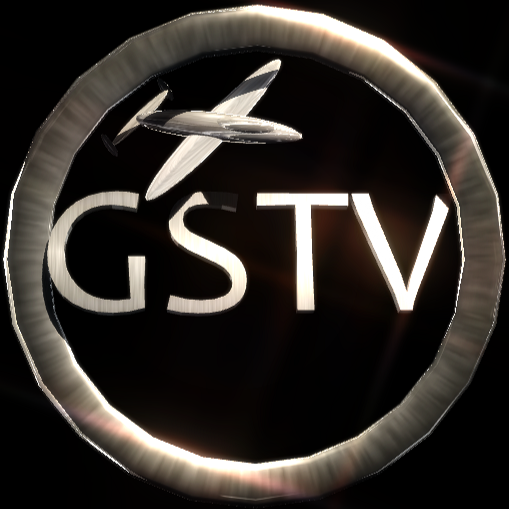

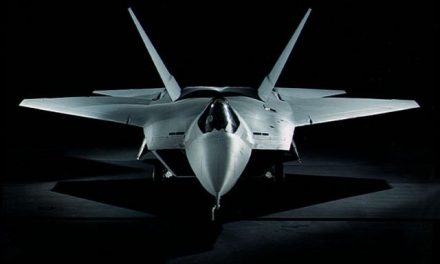
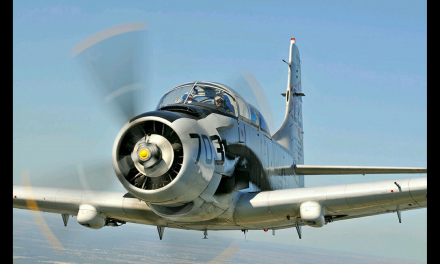
Recent Comments